Shumin Deng
Reasoning Through Memorization: Nearest Neighbor Knowledge Graph Embeddings
Jan 14, 2022

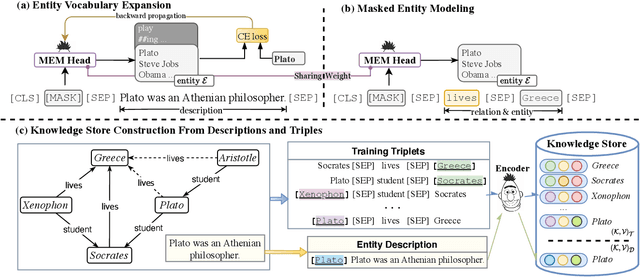
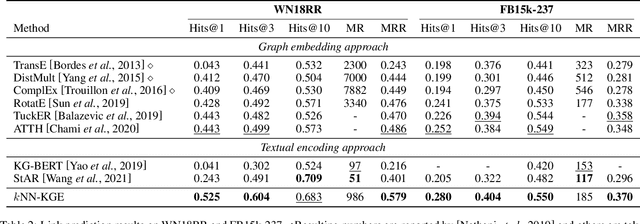
Abstract:Previous knowledge graph embedding approaches usually map entities to representations and utilize score functions to predict the target entities, yet they struggle to reason rare or emerging unseen entities. In this paper, we propose kNN-KGE, a new knowledge graph embedding approach, by linearly interpolating its entity distribution with k-nearest neighbors. We compute the nearest neighbors based on the distance in the entity embedding space from the knowledge store. Our approach can allow rare or emerging entities to be memorized explicitly rather than implicitly in model parameters. Experimental results demonstrate that our approach can improve inductive and transductive link prediction results and yield better performance for low-resource settings with only a few triples, which might be easier to reason via explicit memory.
Knowledge Graph Embedding in E-commerce Applications: Attentive Reasoning, Explanations, and Transferable Rules
Dec 16, 2021
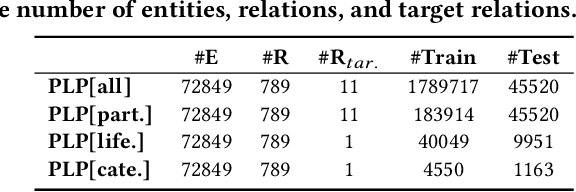
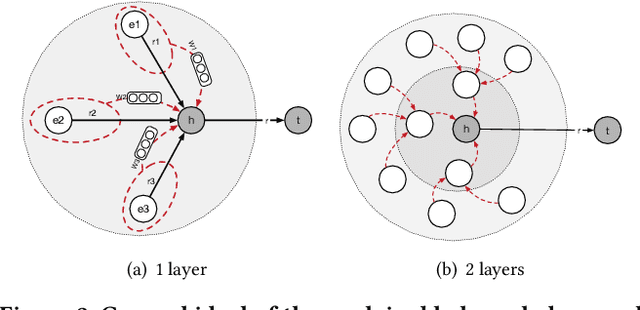

Abstract:Knowledge Graphs (KGs), representing facts as triples, have been widely adopted in many applications. Reasoning tasks such as link prediction and rule induction are important for the development of KGs. Knowledge Graph Embeddings (KGEs) embedding entities and relations of a KG into continuous vector spaces, have been proposed for these reasoning tasks and proven to be efficient and robust. But the plausibility and feasibility of applying and deploying KGEs in real-work applications has not been well-explored. In this paper, we discuss and report our experiences of deploying KGEs in a real domain application: e-commerce. We first identity three important desiderata for e-commerce KG systems: 1) attentive reasoning, reasoning over a few target relations of more concerns instead of all; 2) explanation, providing explanations for a prediction to help both users and business operators understand why the prediction is made; 3) transferable rules, generating reusable rules to accelerate the deployment of a KG to new systems. While non existing KGE could meet all these desiderata, we propose a novel one, an explainable knowledge graph attention network that make prediction through modeling correlations between triples rather than purely relying on its head entity, relation and tail entity embeddings. It could automatically selects attentive triples for prediction and records the contribution of them at the same time, from which explanations could be easily provided and transferable rules could be efficiently produced. We empirically show that our method is capable of meeting all three desiderata in our e-commerce application and outperform typical baselines on datasets from real domain applications.
LOGEN: Few-shot Logical Knowledge-Conditioned Text Generation with Self-training
Dec 02, 2021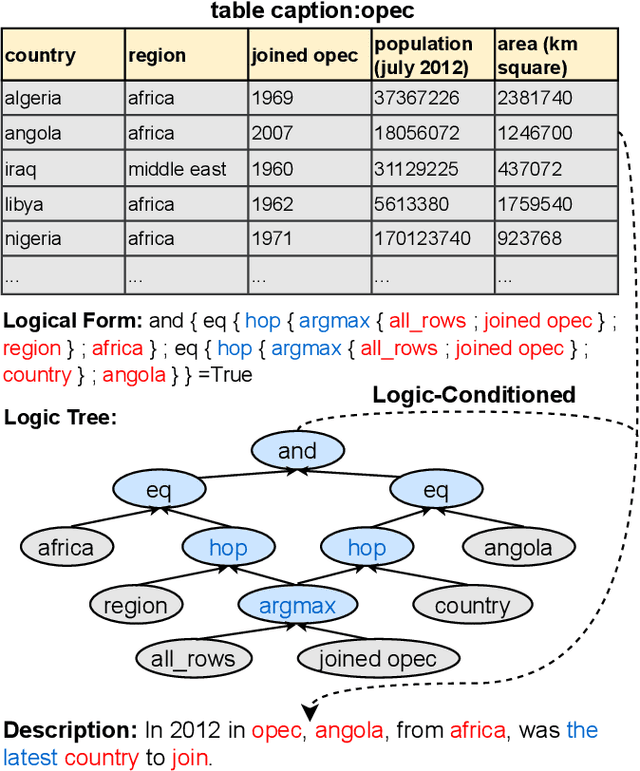
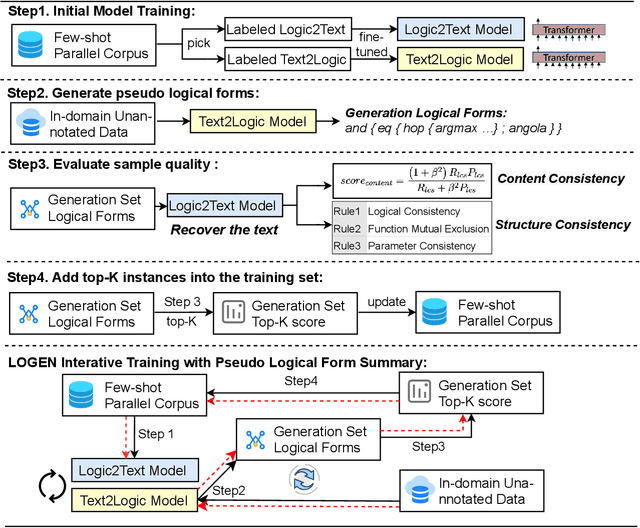
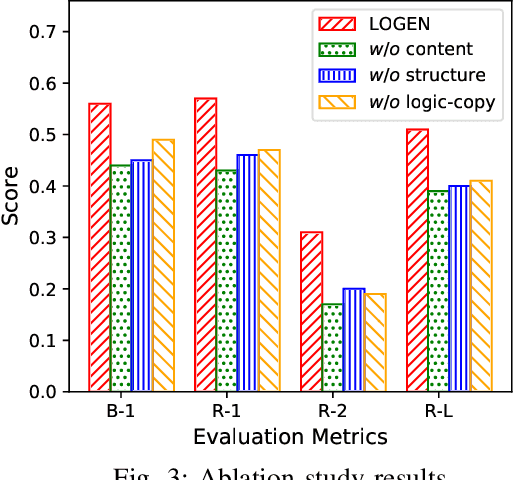

Abstract:Natural language generation from structured data mainly focuses on surface-level descriptions, suffering from uncontrollable content selection and low fidelity. Previous works leverage logical forms to facilitate logical knowledge-conditioned text generation. Though achieving remarkable progress, they are data-hungry, which makes the adoption for real-world applications challenging with limited data. To this end, this paper proposes a unified framework for logical knowledge-conditioned text generation in the few-shot setting. With only a few seeds logical forms (e.g., 20/100 shot), our approach leverages self-training and samples pseudo logical forms based on content and structure consistency. Experimental results demonstrate that our approach can obtain better few-shot performance than baselines.
Molecular Contrastive Learning with Chemical Element Knowledge Graph
Dec 01, 2021
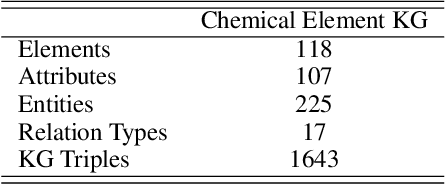

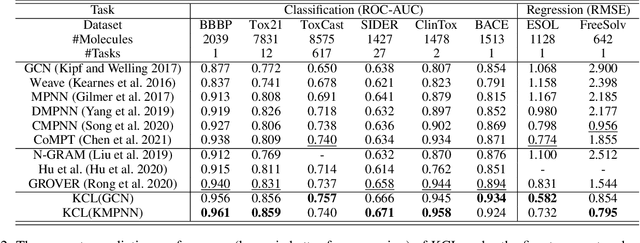
Abstract:Molecular representation learning contributes to multiple downstream tasks such as molecular property prediction and drug design. To properly represent molecules, graph contrastive learning is a promising paradigm as it utilizes self-supervision signals and has no requirements for human annotations. However, prior works fail to incorporate fundamental domain knowledge into graph semantics and thus ignore the correlations between atoms that have common attributes but are not directly connected by bonds. To address these issues, we construct a Chemical Element Knowledge Graph (KG) to summarize microscopic associations between elements and propose a novel Knowledge-enhanced Contrastive Learning (KCL) framework for molecular representation learning. KCL framework consists of three modules. The first module, knowledge-guided graph augmentation, augments the original molecular graph based on the Chemical Element KG. The second module, knowledge-aware graph representation, extracts molecular representations with a common graph encoder for the original molecular graph and a Knowledge-aware Message Passing Neural Network (KMPNN) to encode complex information in the augmented molecular graph. The final module is a contrastive objective, where we maximize agreement between these two views of molecular graphs. Extensive experiments demonstrated that KCL obtained superior performances against state-of-the-art baselines on eight molecular datasets. Visualization experiments properly interpret what KCL has learned from atoms and attributes in the augmented molecular graphs. Our codes and data are available in supplementary materials.
Learning to Ask for Data-Efficient Event Argument Extraction
Oct 01, 2021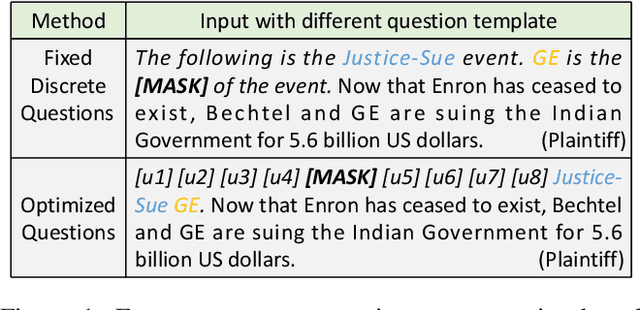
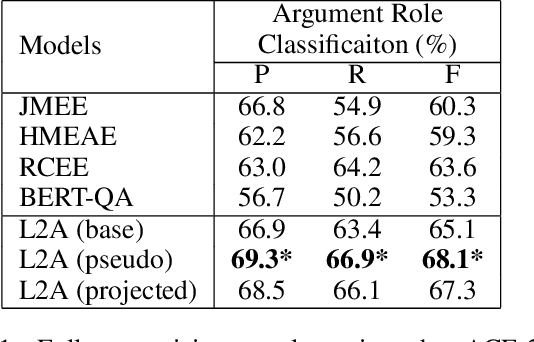
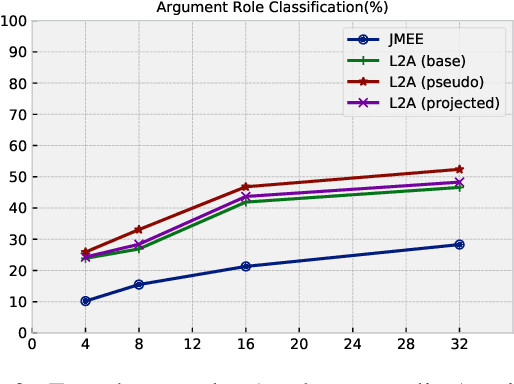
Abstract:Event argument extraction (EAE) is an important task for information extraction to discover specific argument roles. In this study, we cast EAE as a question-based cloze task and empirically analyze fixed discrete token template performance. As generating human-annotated question templates is often time-consuming and labor-intensive, we further propose a novel approach called "Learning to Ask," which can learn optimized question templates for EAE without human annotations. Experiments using the ACE-2005 dataset demonstrate that our method based on optimized questions achieves state-of-the-art performance in both the few-shot and supervised settings.
LightNER: A Lightweight Generative Framework with Prompt-guided Attention for Low-resource NER
Sep 09, 2021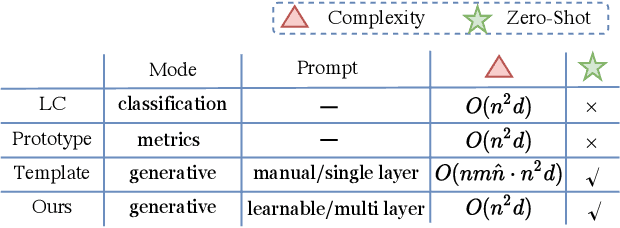
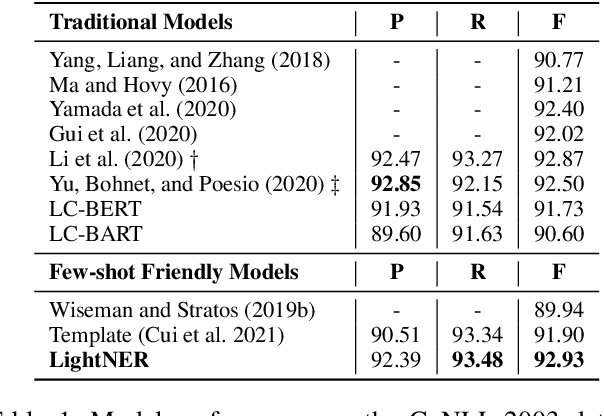
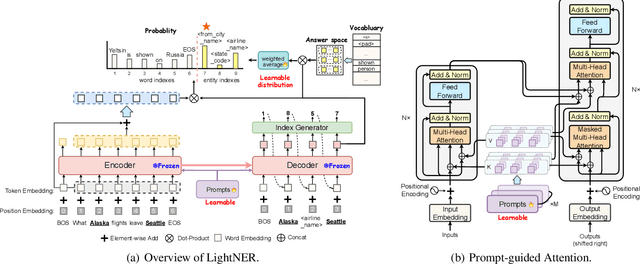

Abstract:Most existing NER methods rely on extensive labeled data for model training, which struggles in the low-resource scenarios with limited training data. Recently, prompt-tuning methods for pre-trained language models have achieved remarkable performance in few-shot learning by exploiting prompts as task guidance to reduce the gap between training progress and downstream tuning. Inspired by prompt learning, we propose a novel lightweight generative framework with prompt-guided attention for low-resource NER (LightNER). Specifically, we construct the semantic-aware answer space of entity categories for prompt learning to generate the entity span sequence and entity categories without any label-specific classifiers. We further propose prompt-guided attention by incorporating continuous prompts into the self-attention layer to re-modulate the attention and adapt pre-trained weights. Note that we only tune those continuous prompts with the whole parameter of the pre-trained language model fixed, thus, making our approach lightweight and flexible for low-resource scenarios and can better transfer knowledge across domains. Experimental results show that LightNER can obtain comparable performance in the standard supervised setting and outperform strong baselines in low-resource settings by tuning only a small part of the parameters.
Differentiable Prompt Makes Pre-trained Language Models Better Few-shot Learners
Aug 31, 2021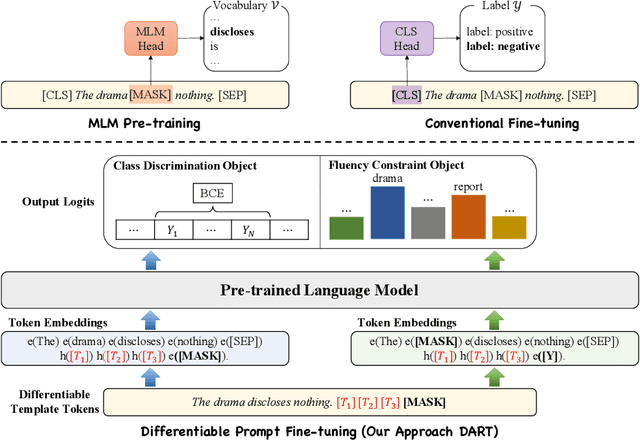

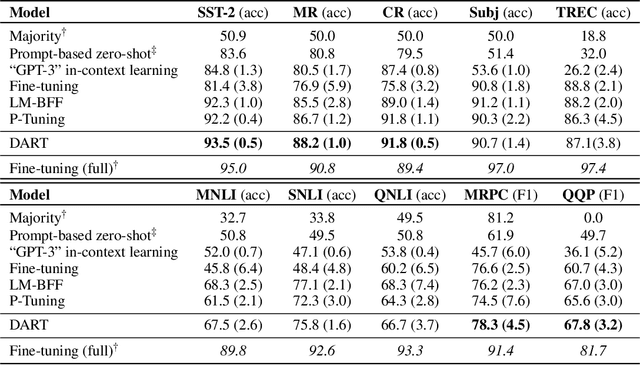
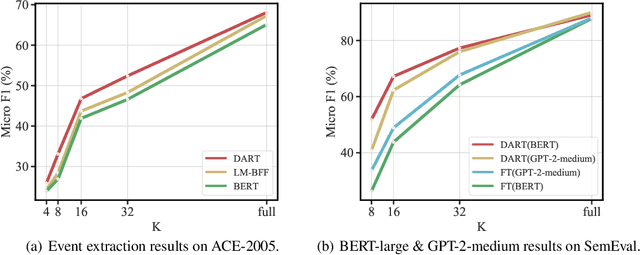
Abstract:Large-scale pre-trained language models have contributed significantly to natural language processing by demonstrating remarkable abilities as few-shot learners. However, their effectiveness depends mainly on scaling the model parameters and prompt design, hindering their implementation in most real-world applications. This study proposes a novel pluggable, extensible, and efficient approach named DifferentiAble pRompT (DART), which can convert small language models into better few-shot learners without any prompt engineering. The main principle behind this approach involves reformulating potential natural language processing tasks into the task of a pre-trained language model and differentially optimizing the prompt template as well as the target label with backpropagation. Furthermore, the proposed approach can be: (i) Plugged to any pre-trained language models; (ii) Extended to widespread classification tasks. A comprehensive evaluation of standard NLP tasks demonstrates that the proposed approach achieves a better few-shot performance.
Document-level Relation Extraction as Semantic Segmentation
Jun 07, 2021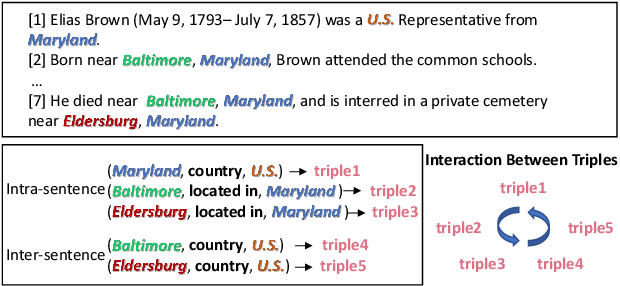
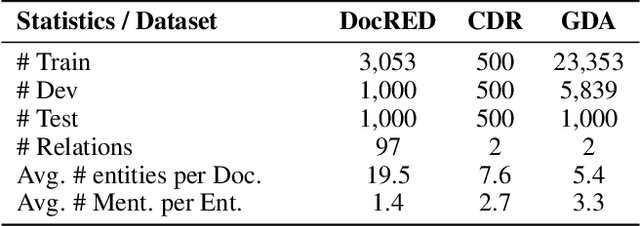
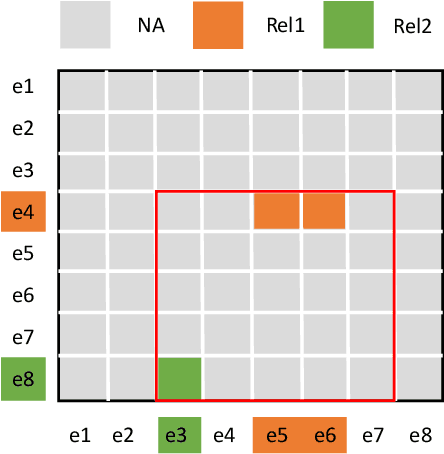
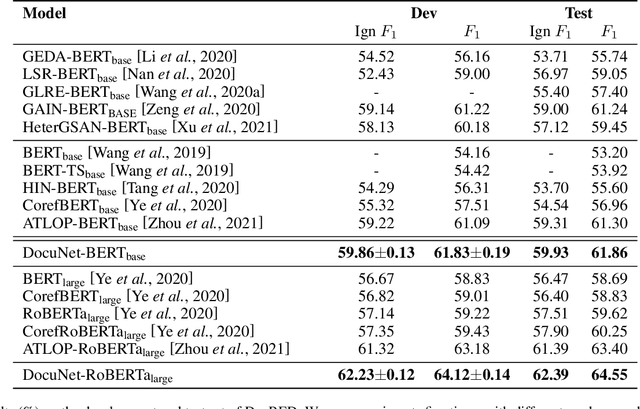
Abstract:Document-level relation extraction aims to extract relations among multiple entity pairs from a document. Previously proposed graph-based or transformer-based models utilize the entities independently, regardless of global information among relational triples. This paper approaches the problem by predicting an entity-level relation matrix to capture local and global information, parallel to the semantic segmentation task in computer vision. Herein, we propose a Document U-shaped Network for document-level relation extraction. Specifically, we leverage an encoder module to capture the context information of entities and a U-shaped segmentation module over the image-style feature map to capture global interdependency among triples. Experimental results show that our approach can obtain state-of-the-art performance on three benchmark datasets DocRED, CDR, and GDA.
AliCG: Fine-grained and Evolvable Conceptual Graph Construction for Semantic Search at Alibaba
Jun 03, 2021
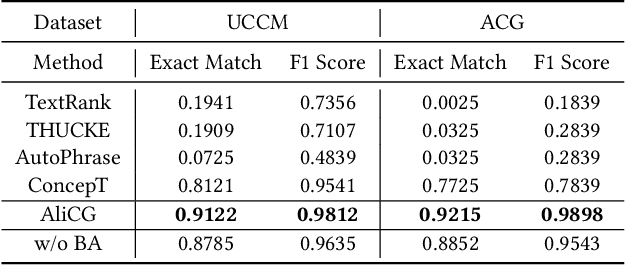
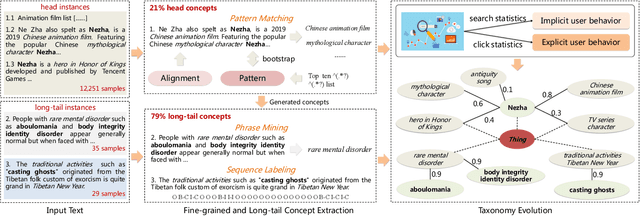
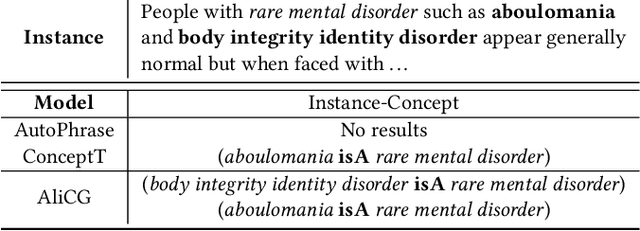
Abstract:Conceptual graphs, which is a particular type of Knowledge Graphs, play an essential role in semantic search. Prior conceptual graph construction approaches typically extract high-frequent, coarse-grained, and time-invariant concepts from formal texts. In real applications, however, it is necessary to extract less-frequent, fine-grained, and time-varying conceptual knowledge and build taxonomy in an evolving manner. In this paper, we introduce an approach to implementing and deploying the conceptual graph at Alibaba. Specifically, We propose a framework called AliCG which is capable of a) extracting fine-grained concepts by a novel bootstrapping with alignment consensus approach, b) mining long-tail concepts with a novel low-resource phrase mining approach, c) updating the graph dynamically via a concept distribution estimation method based on implicit and explicit user behaviors. We have deployed the framework at Alibaba UC Browser. Extensive offline evaluation as well as online A/B testing demonstrate the efficacy of our approach.
MLBiNet: A Cross-Sentence Collective Event Detection Network
Jun 01, 2021

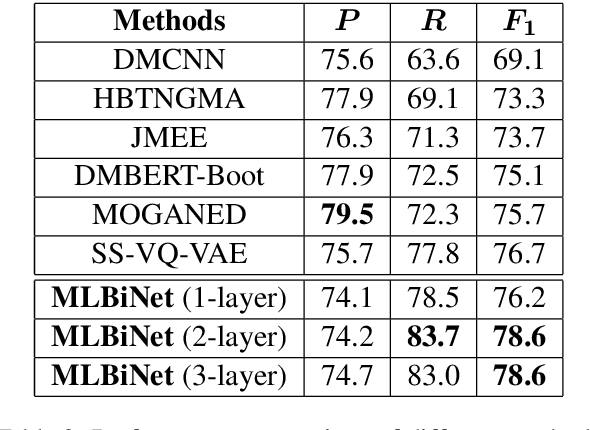
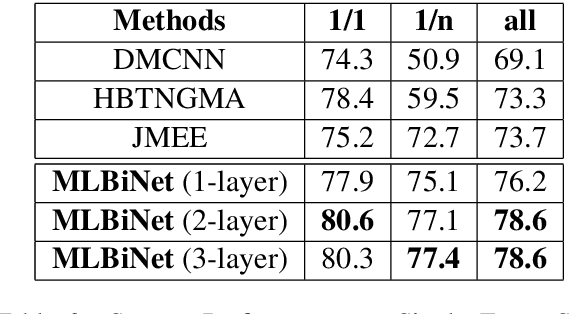
Abstract:We consider the problem of collectively detecting multiple events, particularly in cross-sentence settings. The key to dealing with the problem is to encode semantic information and model event inter-dependency at a document-level. In this paper, we reformulate it as a Seq2Seq task and propose a Multi-Layer Bidirectional Network (MLBiNet) to capture the document-level association of events and semantic information simultaneously. Specifically, a bidirectional decoder is firstly devised to model event inter-dependency within a sentence when decoding the event tag vector sequence. Secondly, an information aggregation module is employed to aggregate sentence-level semantic and event tag information. Finally, we stack multiple bidirectional decoders and feed cross-sentence information, forming a multi-layer bidirectional tagging architecture to iteratively propagate information across sentences. We show that our approach provides significant improvement in performance compared to the current state-of-the-art results.
 Add to Chrome
Add to Chrome Add to Firefox
Add to Firefox Add to Edge
Add to Edge